Organizational Strategies for Aston Martin
VerifiedAdded on 2023/01/19
|10
|3157
|47
AI Summary
This report discusses the organizational strategies of Aston Martin, including a PESTLE analysis of macro-environmental factors, the industry position of the company, internal resources and capabilities, and stakeholder perspectives. It provides insights into how these factors impact Aston Martin's profitability and growth.
Contribute Materials
Your contribution can guide someone’s learning journey. Share your
documents today.
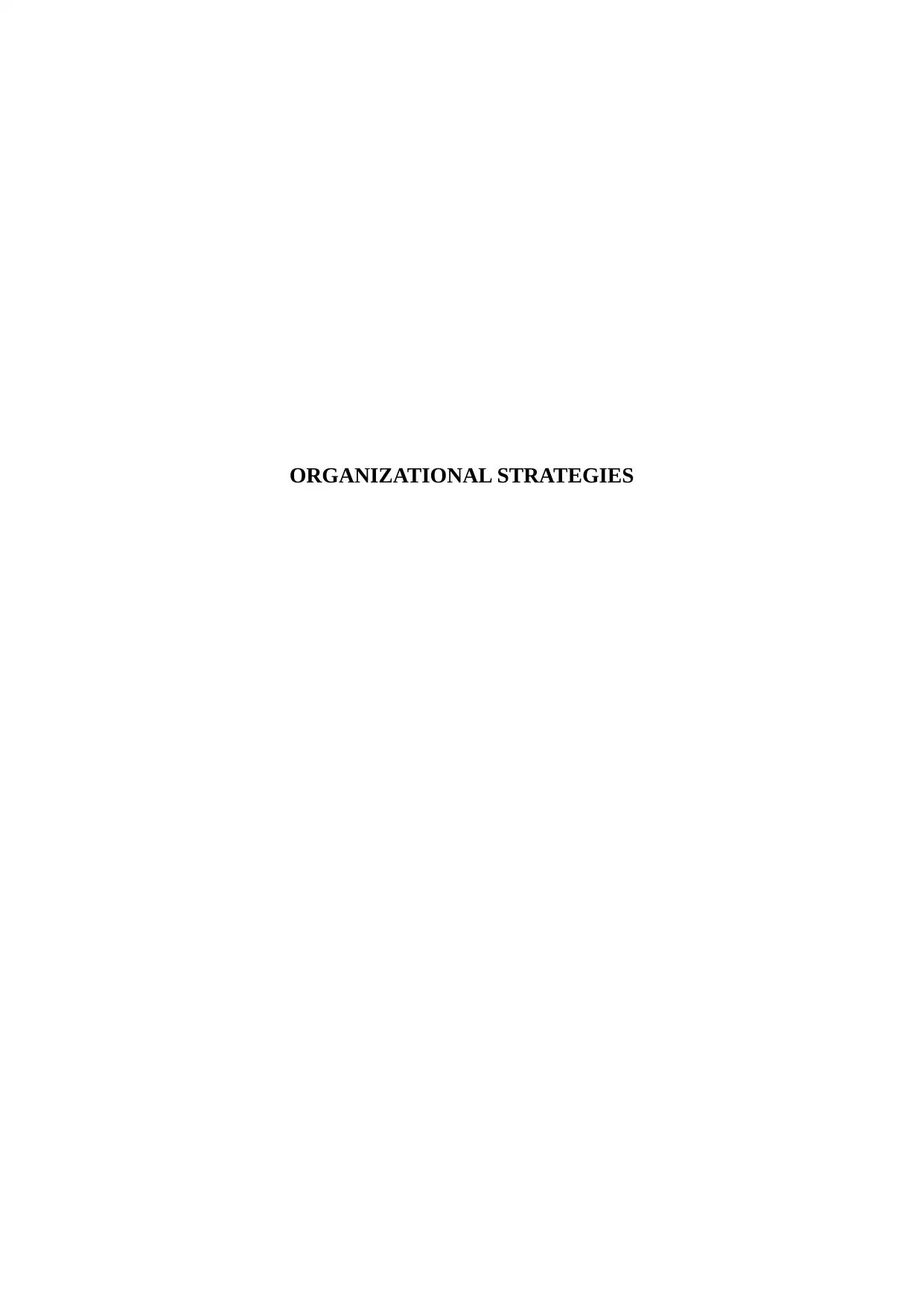
ORGANIZATIONAL STRATEGIES
Secure Best Marks with AI Grader
Need help grading? Try our AI Grader for instant feedback on your assignments.

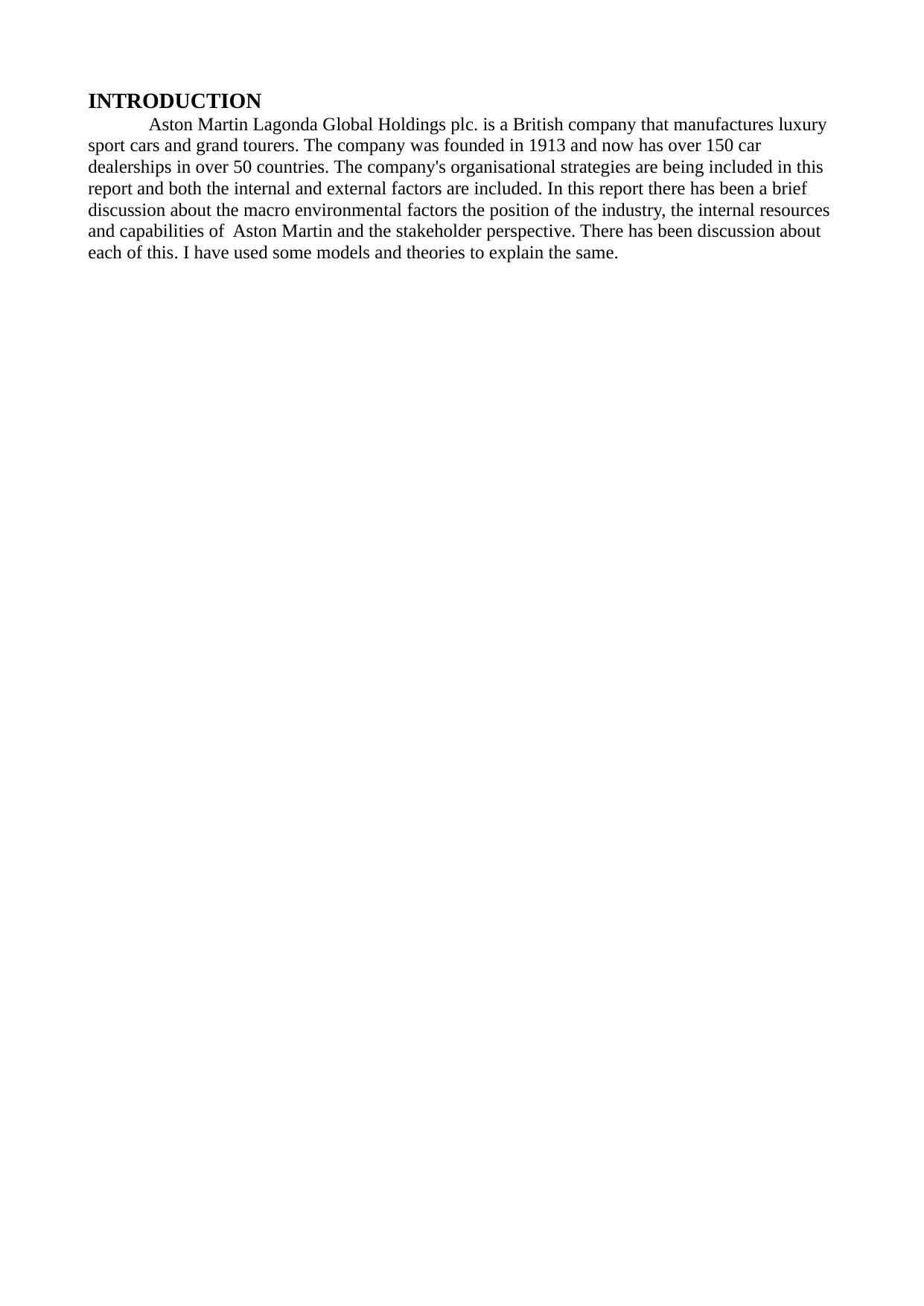
INTRODUCTION
Aston Martin Lagonda Global Holdings plc. is a British company that manufactures luxury
sport cars and grand tourers. The company was founded in 1913 and now has over 150 car
dealerships in over 50 countries. The company's organisational strategies are being included in this
report and both the internal and external factors are included. In this report there has been a brief
discussion about the macro environmental factors the position of the industry, the internal resources
and capabilities of Aston Martin and the stakeholder perspective. There has been discussion about
each of this. I have used some models and theories to explain the same.
Aston Martin Lagonda Global Holdings plc. is a British company that manufactures luxury
sport cars and grand tourers. The company was founded in 1913 and now has over 150 car
dealerships in over 50 countries. The company's organisational strategies are being included in this
report and both the internal and external factors are included. In this report there has been a brief
discussion about the macro environmental factors the position of the industry, the internal resources
and capabilities of Aston Martin and the stakeholder perspective. There has been discussion about
each of this. I have used some models and theories to explain the same.
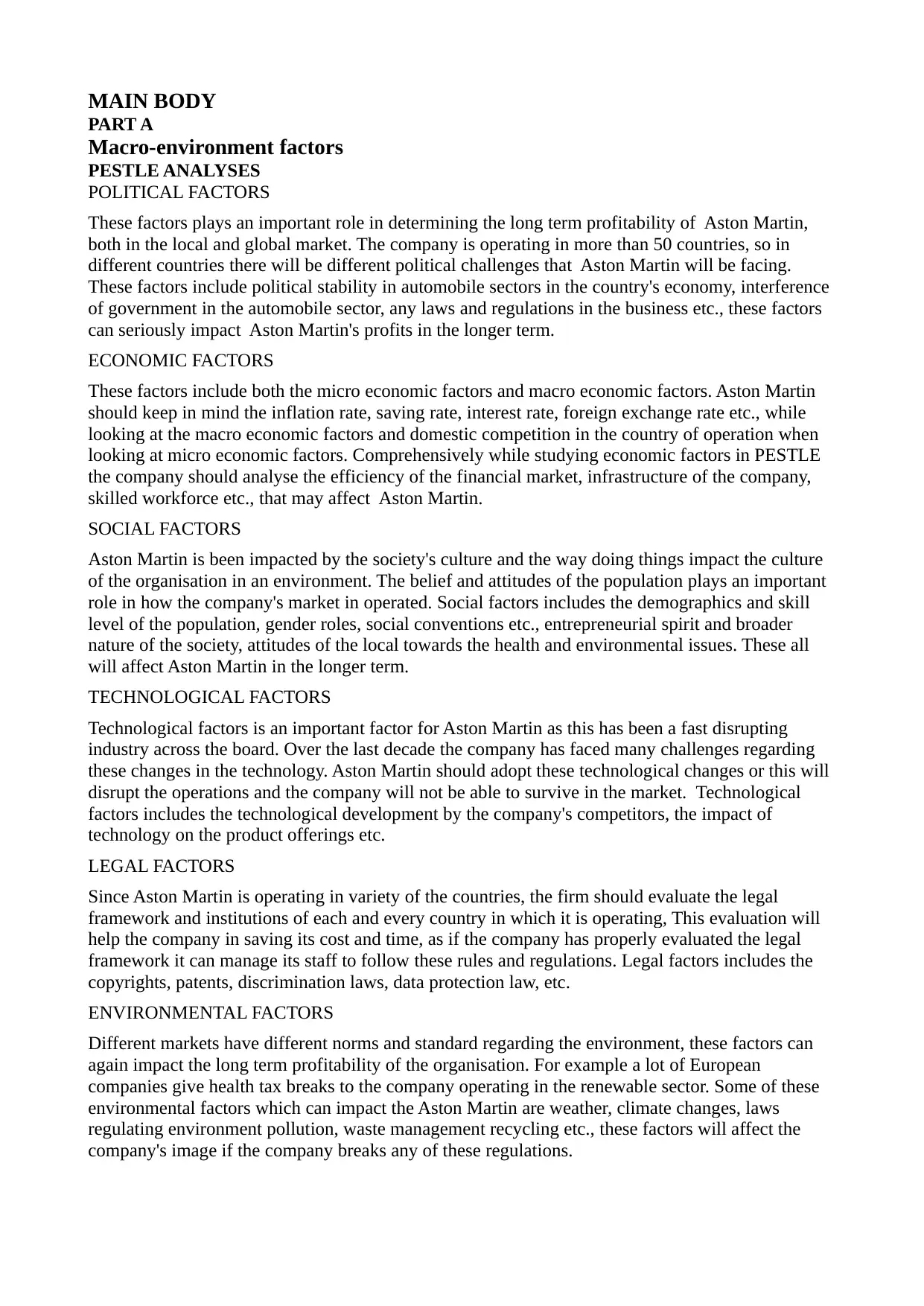
MAIN BODY
PART A
Macro-environment factors
PESTLE ANALYSES
POLITICAL FACTORS
These factors plays an important role in determining the long term profitability of Aston Martin,
both in the local and global market. The company is operating in more than 50 countries, so in
different countries there will be different political challenges that Aston Martin will be facing.
These factors include political stability in automobile sectors in the country's economy, interference
of government in the automobile sector, any laws and regulations in the business etc., these factors
can seriously impact Aston Martin's profits in the longer term.
ECONOMIC FACTORS
These factors include both the micro economic factors and macro economic factors. Aston Martin
should keep in mind the inflation rate, saving rate, interest rate, foreign exchange rate etc., while
looking at the macro economic factors and domestic competition in the country of operation when
looking at micro economic factors. Comprehensively while studying economic factors in PESTLE
the company should analyse the efficiency of the financial market, infrastructure of the company,
skilled workforce etc., that may affect Aston Martin.
SOCIAL FACTORS
Aston Martin is been impacted by the society's culture and the way doing things impact the culture
of the organisation in an environment. The belief and attitudes of the population plays an important
role in how the company's market in operated. Social factors includes the demographics and skill
level of the population, gender roles, social conventions etc., entrepreneurial spirit and broader
nature of the society, attitudes of the local towards the health and environmental issues. These all
will affect Aston Martin in the longer term.
TECHNOLOGICAL FACTORS
Technological factors is an important factor for Aston Martin as this has been a fast disrupting
industry across the board. Over the last decade the company has faced many challenges regarding
these changes in the technology. Aston Martin should adopt these technological changes or this will
disrupt the operations and the company will not be able to survive in the market. Technological
factors includes the technological development by the company's competitors, the impact of
technology on the product offerings etc.
LEGAL FACTORS
Since Aston Martin is operating in variety of the countries, the firm should evaluate the legal
framework and institutions of each and every country in which it is operating, This evaluation will
help the company in saving its cost and time, as if the company has properly evaluated the legal
framework it can manage its staff to follow these rules and regulations. Legal factors includes the
copyrights, patents, discrimination laws, data protection law, etc.
ENVIRONMENTAL FACTORS
Different markets have different norms and standard regarding the environment, these factors can
again impact the long term profitability of the organisation. For example a lot of European
companies give health tax breaks to the company operating in the renewable sector. Some of these
environmental factors which can impact the Aston Martin are weather, climate changes, laws
regulating environment pollution, waste management recycling etc., these factors will affect the
company's image if the company breaks any of these regulations.
PART A
Macro-environment factors
PESTLE ANALYSES
POLITICAL FACTORS
These factors plays an important role in determining the long term profitability of Aston Martin,
both in the local and global market. The company is operating in more than 50 countries, so in
different countries there will be different political challenges that Aston Martin will be facing.
These factors include political stability in automobile sectors in the country's economy, interference
of government in the automobile sector, any laws and regulations in the business etc., these factors
can seriously impact Aston Martin's profits in the longer term.
ECONOMIC FACTORS
These factors include both the micro economic factors and macro economic factors. Aston Martin
should keep in mind the inflation rate, saving rate, interest rate, foreign exchange rate etc., while
looking at the macro economic factors and domestic competition in the country of operation when
looking at micro economic factors. Comprehensively while studying economic factors in PESTLE
the company should analyse the efficiency of the financial market, infrastructure of the company,
skilled workforce etc., that may affect Aston Martin.
SOCIAL FACTORS
Aston Martin is been impacted by the society's culture and the way doing things impact the culture
of the organisation in an environment. The belief and attitudes of the population plays an important
role in how the company's market in operated. Social factors includes the demographics and skill
level of the population, gender roles, social conventions etc., entrepreneurial spirit and broader
nature of the society, attitudes of the local towards the health and environmental issues. These all
will affect Aston Martin in the longer term.
TECHNOLOGICAL FACTORS
Technological factors is an important factor for Aston Martin as this has been a fast disrupting
industry across the board. Over the last decade the company has faced many challenges regarding
these changes in the technology. Aston Martin should adopt these technological changes or this will
disrupt the operations and the company will not be able to survive in the market. Technological
factors includes the technological development by the company's competitors, the impact of
technology on the product offerings etc.
LEGAL FACTORS
Since Aston Martin is operating in variety of the countries, the firm should evaluate the legal
framework and institutions of each and every country in which it is operating, This evaluation will
help the company in saving its cost and time, as if the company has properly evaluated the legal
framework it can manage its staff to follow these rules and regulations. Legal factors includes the
copyrights, patents, discrimination laws, data protection law, etc.
ENVIRONMENTAL FACTORS
Different markets have different norms and standard regarding the environment, these factors can
again impact the long term profitability of the organisation. For example a lot of European
companies give health tax breaks to the company operating in the renewable sector. Some of these
environmental factors which can impact the Aston Martin are weather, climate changes, laws
regulating environment pollution, waste management recycling etc., these factors will affect the
company's image if the company breaks any of these regulations.
Secure Best Marks with AI Grader
Need help grading? Try our AI Grader for instant feedback on your assignments.
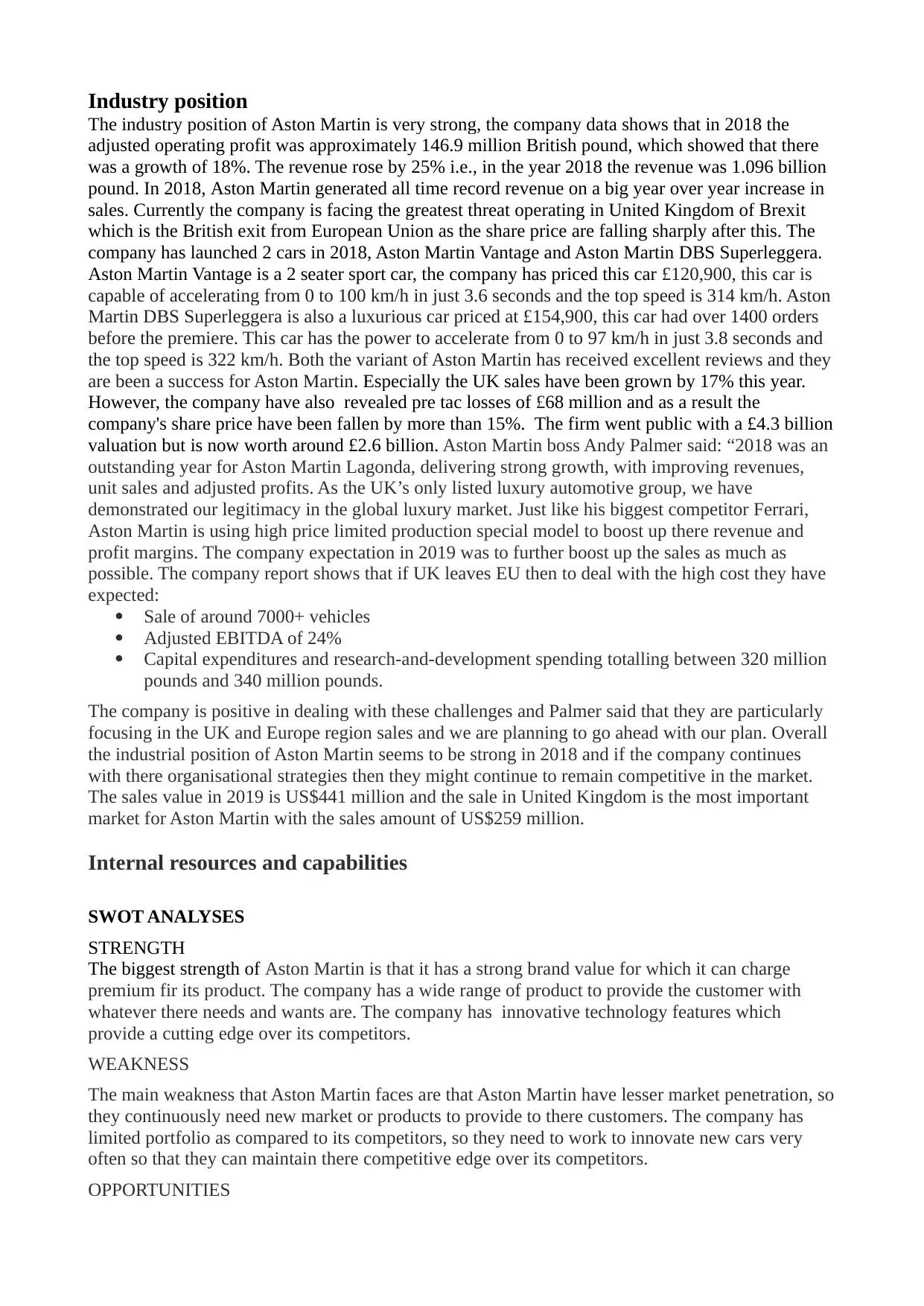
Industry position
The industry position of Aston Martin is very strong, the company data shows that in 2018 the
adjusted operating profit was approximately 146.9 million British pound, which showed that there
was a growth of 18%. The revenue rose by 25% i.e., in the year 2018 the revenue was 1.096 billion
pound. In 2018, Aston Martin generated all time record revenue on a big year over year increase in
sales. Currently the company is facing the greatest threat operating in United Kingdom of Brexit
which is the British exit from European Union as the share price are falling sharply after this. The
company has launched 2 cars in 2018, Aston Martin Vantage and Aston Martin DBS Superleggera.
Aston Martin Vantage is a 2 seater sport car, the company has priced this car £120,900, this car is
capable of accelerating from 0 to 100 km/h in just 3.6 seconds and the top speed is 314 km/h. Aston
Martin DBS Superleggera is also a luxurious car priced at £154,900, this car had over 1400 orders
before the premiere. This car has the power to accelerate from 0 to 97 km/h in just 3.8 seconds and
the top speed is 322 km/h. Both the variant of Aston Martin has received excellent reviews and they
are been a success for Aston Martin. Especially the UK sales have been grown by 17% this year.
However, the company have also revealed pre tac losses of £68 million and as a result the
company's share price have been fallen by more than 15%. The firm went public with a £4.3 billion
valuation but is now worth around £2.6 billion. Aston Martin boss Andy Palmer said: “2018 was an
outstanding year for Aston Martin Lagonda, delivering strong growth, with improving revenues,
unit sales and adjusted profits. As the UK’s only listed luxury automotive group, we have
demonstrated our legitimacy in the global luxury market. Just like his biggest competitor Ferrari,
Aston Martin is using high price limited production special model to boost up there revenue and
profit margins. The company expectation in 2019 was to further boost up the sales as much as
possible. The company report shows that if UK leaves EU then to deal with the high cost they have
expected:
Sale of around 7000+ vehicles
Adjusted EBITDA of 24%
Capital expenditures and research-and-development spending totalling between 320 million
pounds and 340 million pounds.
The company is positive in dealing with these challenges and Palmer said that they are particularly
focusing in the UK and Europe region sales and we are planning to go ahead with our plan. Overall
the industrial position of Aston Martin seems to be strong in 2018 and if the company continues
with there organisational strategies then they might continue to remain competitive in the market.
The sales value in 2019 is US$441 million and the sale in United Kingdom is the most important
market for Aston Martin with the sales amount of US$259 million.
Internal resources and capabilities
SWOT ANALYSES
STRENGTH
The biggest strength of Aston Martin is that it has a strong brand value for which it can charge
premium fir its product. The company has a wide range of product to provide the customer with
whatever there needs and wants are. The company has innovative technology features which
provide a cutting edge over its competitors.
WEAKNESS
The main weakness that Aston Martin faces are that Aston Martin have lesser market penetration, so
they continuously need new market or products to provide to there customers. The company has
limited portfolio as compared to its competitors, so they need to work to innovate new cars very
often so that they can maintain there competitive edge over its competitors.
OPPORTUNITIES
The industry position of Aston Martin is very strong, the company data shows that in 2018 the
adjusted operating profit was approximately 146.9 million British pound, which showed that there
was a growth of 18%. The revenue rose by 25% i.e., in the year 2018 the revenue was 1.096 billion
pound. In 2018, Aston Martin generated all time record revenue on a big year over year increase in
sales. Currently the company is facing the greatest threat operating in United Kingdom of Brexit
which is the British exit from European Union as the share price are falling sharply after this. The
company has launched 2 cars in 2018, Aston Martin Vantage and Aston Martin DBS Superleggera.
Aston Martin Vantage is a 2 seater sport car, the company has priced this car £120,900, this car is
capable of accelerating from 0 to 100 km/h in just 3.6 seconds and the top speed is 314 km/h. Aston
Martin DBS Superleggera is also a luxurious car priced at £154,900, this car had over 1400 orders
before the premiere. This car has the power to accelerate from 0 to 97 km/h in just 3.8 seconds and
the top speed is 322 km/h. Both the variant of Aston Martin has received excellent reviews and they
are been a success for Aston Martin. Especially the UK sales have been grown by 17% this year.
However, the company have also revealed pre tac losses of £68 million and as a result the
company's share price have been fallen by more than 15%. The firm went public with a £4.3 billion
valuation but is now worth around £2.6 billion. Aston Martin boss Andy Palmer said: “2018 was an
outstanding year for Aston Martin Lagonda, delivering strong growth, with improving revenues,
unit sales and adjusted profits. As the UK’s only listed luxury automotive group, we have
demonstrated our legitimacy in the global luxury market. Just like his biggest competitor Ferrari,
Aston Martin is using high price limited production special model to boost up there revenue and
profit margins. The company expectation in 2019 was to further boost up the sales as much as
possible. The company report shows that if UK leaves EU then to deal with the high cost they have
expected:
Sale of around 7000+ vehicles
Adjusted EBITDA of 24%
Capital expenditures and research-and-development spending totalling between 320 million
pounds and 340 million pounds.
The company is positive in dealing with these challenges and Palmer said that they are particularly
focusing in the UK and Europe region sales and we are planning to go ahead with our plan. Overall
the industrial position of Aston Martin seems to be strong in 2018 and if the company continues
with there organisational strategies then they might continue to remain competitive in the market.
The sales value in 2019 is US$441 million and the sale in United Kingdom is the most important
market for Aston Martin with the sales amount of US$259 million.
Internal resources and capabilities
SWOT ANALYSES
STRENGTH
The biggest strength of Aston Martin is that it has a strong brand value for which it can charge
premium fir its product. The company has a wide range of product to provide the customer with
whatever there needs and wants are. The company has innovative technology features which
provide a cutting edge over its competitors.
WEAKNESS
The main weakness that Aston Martin faces are that Aston Martin have lesser market penetration, so
they continuously need new market or products to provide to there customers. The company has
limited portfolio as compared to its competitors, so they need to work to innovate new cars very
often so that they can maintain there competitive edge over its competitors.
OPPORTUNITIES
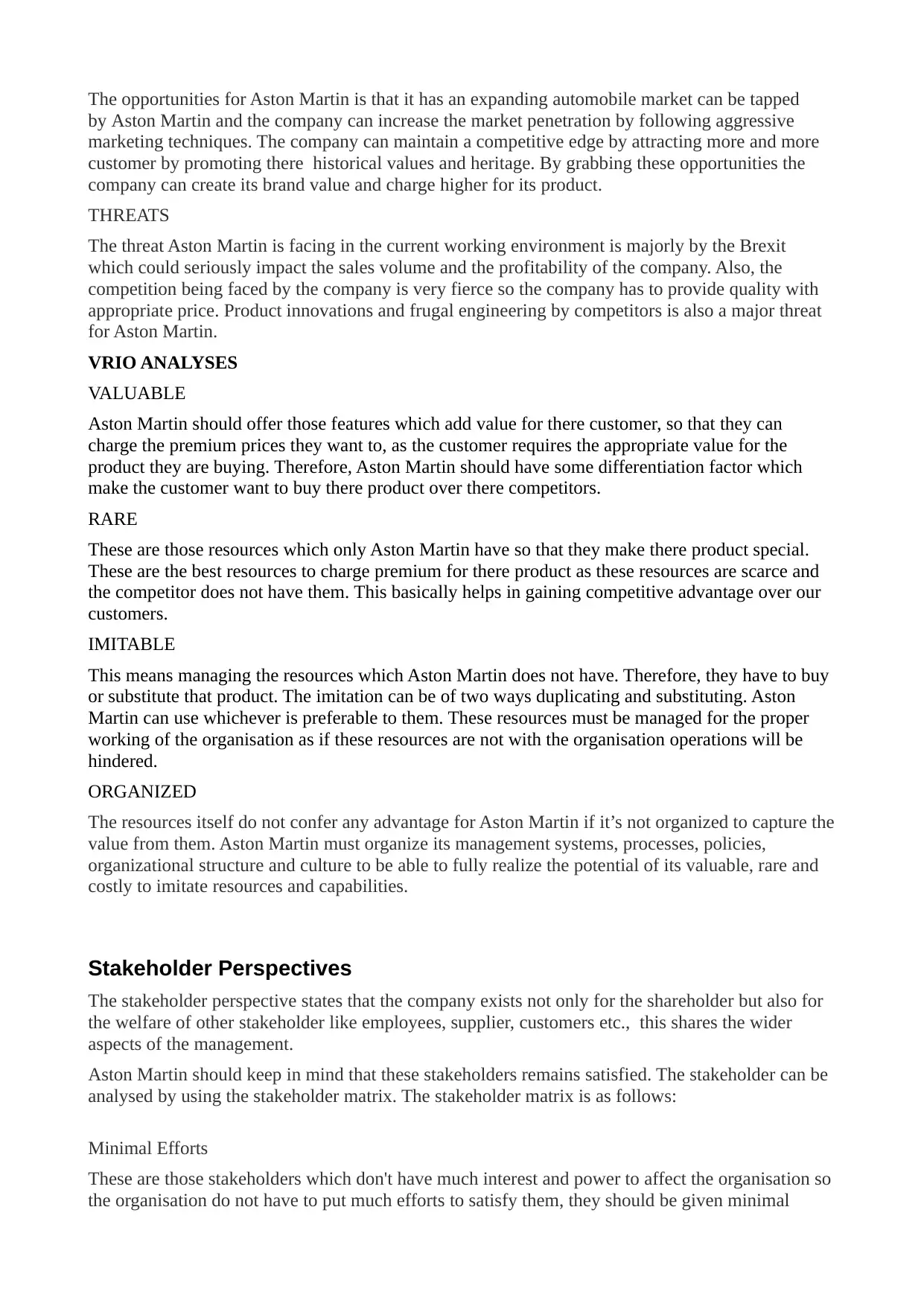
The opportunities for Aston Martin is that it has an expanding automobile market can be tapped
by Aston Martin and the company can increase the market penetration by following aggressive
marketing techniques. The company can maintain a competitive edge by attracting more and more
customer by promoting there historical values and heritage. By grabbing these opportunities the
company can create its brand value and charge higher for its product.
THREATS
The threat Aston Martin is facing in the current working environment is majorly by the Brexit
which could seriously impact the sales volume and the profitability of the company. Also, the
competition being faced by the company is very fierce so the company has to provide quality with
appropriate price. Product innovations and frugal engineering by competitors is also a major threat
for Aston Martin.
VRIO ANALYSES
VALUABLE
Aston Martin should offer those features which add value for there customer, so that they can
charge the premium prices they want to, as the customer requires the appropriate value for the
product they are buying. Therefore, Aston Martin should have some differentiation factor which
make the customer want to buy there product over there competitors.
RARE
These are those resources which only Aston Martin have so that they make there product special.
These are the best resources to charge premium for there product as these resources are scarce and
the competitor does not have them. This basically helps in gaining competitive advantage over our
customers.
IMITABLE
This means managing the resources which Aston Martin does not have. Therefore, they have to buy
or substitute that product. The imitation can be of two ways duplicating and substituting. Aston
Martin can use whichever is preferable to them. These resources must be managed for the proper
working of the organisation as if these resources are not with the organisation operations will be
hindered.
ORGANIZED
The resources itself do not confer any advantage for Aston Martin if it’s not organized to capture the
value from them. Aston Martin must organize its management systems, processes, policies,
organizational structure and culture to be able to fully realize the potential of its valuable, rare and
costly to imitate resources and capabilities.
Stakeholder Perspectives
The stakeholder perspective states that the company exists not only for the shareholder but also for
the welfare of other stakeholder like employees, supplier, customers etc., this shares the wider
aspects of the management.
Aston Martin should keep in mind that these stakeholders remains satisfied. The stakeholder can be
analysed by using the stakeholder matrix. The stakeholder matrix is as follows:
Minimal Efforts
These are those stakeholders which don't have much interest and power to affect the organisation so
the organisation do not have to put much efforts to satisfy them, they should be given minimal
by Aston Martin and the company can increase the market penetration by following aggressive
marketing techniques. The company can maintain a competitive edge by attracting more and more
customer by promoting there historical values and heritage. By grabbing these opportunities the
company can create its brand value and charge higher for its product.
THREATS
The threat Aston Martin is facing in the current working environment is majorly by the Brexit
which could seriously impact the sales volume and the profitability of the company. Also, the
competition being faced by the company is very fierce so the company has to provide quality with
appropriate price. Product innovations and frugal engineering by competitors is also a major threat
for Aston Martin.
VRIO ANALYSES
VALUABLE
Aston Martin should offer those features which add value for there customer, so that they can
charge the premium prices they want to, as the customer requires the appropriate value for the
product they are buying. Therefore, Aston Martin should have some differentiation factor which
make the customer want to buy there product over there competitors.
RARE
These are those resources which only Aston Martin have so that they make there product special.
These are the best resources to charge premium for there product as these resources are scarce and
the competitor does not have them. This basically helps in gaining competitive advantage over our
customers.
IMITABLE
This means managing the resources which Aston Martin does not have. Therefore, they have to buy
or substitute that product. The imitation can be of two ways duplicating and substituting. Aston
Martin can use whichever is preferable to them. These resources must be managed for the proper
working of the organisation as if these resources are not with the organisation operations will be
hindered.
ORGANIZED
The resources itself do not confer any advantage for Aston Martin if it’s not organized to capture the
value from them. Aston Martin must organize its management systems, processes, policies,
organizational structure and culture to be able to fully realize the potential of its valuable, rare and
costly to imitate resources and capabilities.
Stakeholder Perspectives
The stakeholder perspective states that the company exists not only for the shareholder but also for
the welfare of other stakeholder like employees, supplier, customers etc., this shares the wider
aspects of the management.
Aston Martin should keep in mind that these stakeholders remains satisfied. The stakeholder can be
analysed by using the stakeholder matrix. The stakeholder matrix is as follows:
Minimal Efforts
These are those stakeholders which don't have much interest and power to affect the organisation so
the organisation do not have to put much efforts to satisfy them, they should be given minimal
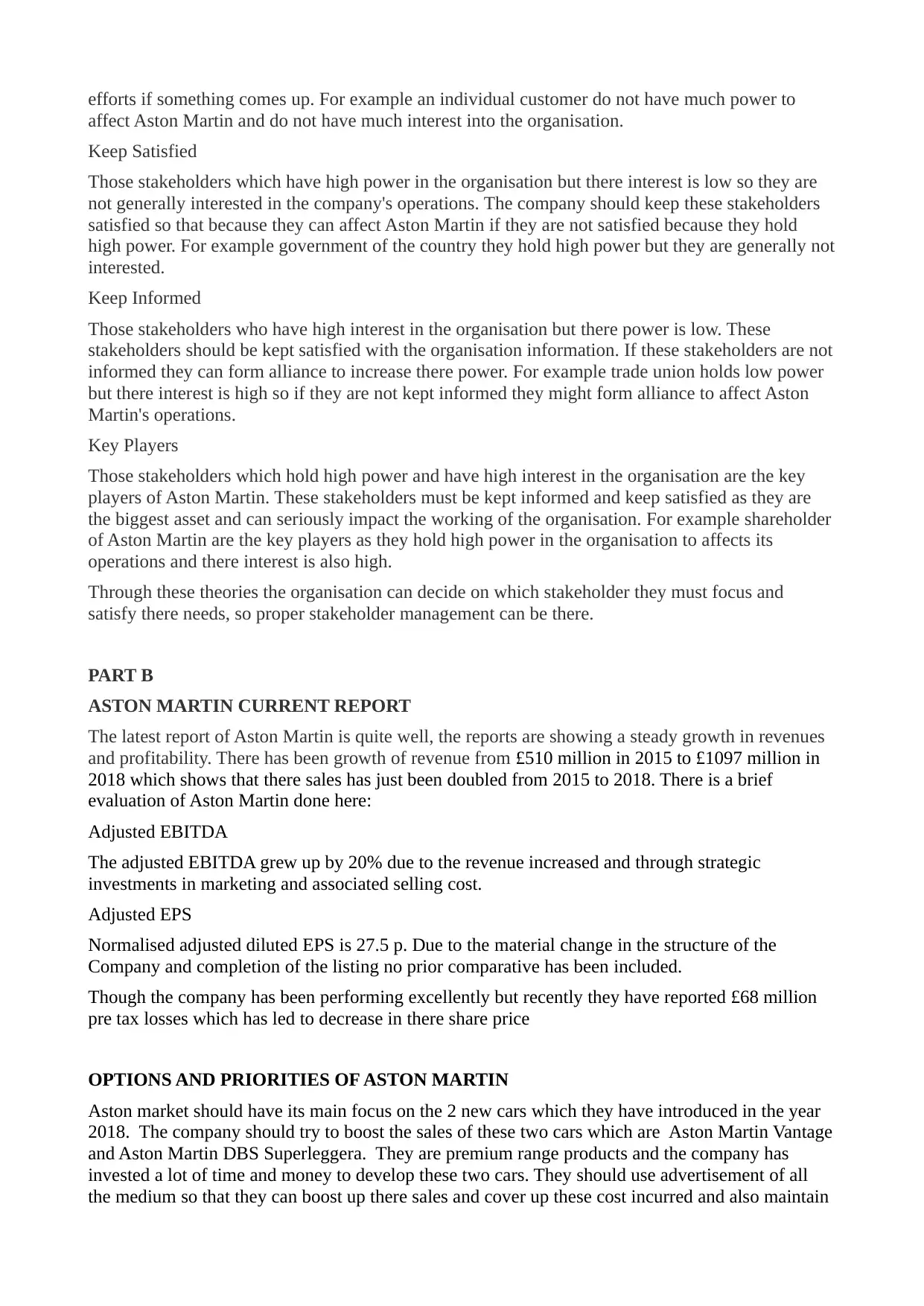
efforts if something comes up. For example an individual customer do not have much power to
affect Aston Martin and do not have much interest into the organisation.
Keep Satisfied
Those stakeholders which have high power in the organisation but there interest is low so they are
not generally interested in the company's operations. The company should keep these stakeholders
satisfied so that because they can affect Aston Martin if they are not satisfied because they hold
high power. For example government of the country they hold high power but they are generally not
interested.
Keep Informed
Those stakeholders who have high interest in the organisation but there power is low. These
stakeholders should be kept satisfied with the organisation information. If these stakeholders are not
informed they can form alliance to increase there power. For example trade union holds low power
but there interest is high so if they are not kept informed they might form alliance to affect Aston
Martin's operations.
Key Players
Those stakeholders which hold high power and have high interest in the organisation are the key
players of Aston Martin. These stakeholders must be kept informed and keep satisfied as they are
the biggest asset and can seriously impact the working of the organisation. For example shareholder
of Aston Martin are the key players as they hold high power in the organisation to affects its
operations and there interest is also high.
Through these theories the organisation can decide on which stakeholder they must focus and
satisfy there needs, so proper stakeholder management can be there.
PART B
ASTON MARTIN CURRENT REPORT
The latest report of Aston Martin is quite well, the reports are showing a steady growth in revenues
and profitability. There has been growth of revenue from £510 million in 2015 to £1097 million in
2018 which shows that there sales has just been doubled from 2015 to 2018. There is a brief
evaluation of Aston Martin done here:
Adjusted EBITDA
The adjusted EBITDA grew up by 20% due to the revenue increased and through strategic
investments in marketing and associated selling cost.
Adjusted EPS
Normalised adjusted diluted EPS is 27.5 p. Due to the material change in the structure of the
Company and completion of the listing no prior comparative has been included.
Though the company has been performing excellently but recently they have reported £68 million
pre tax losses which has led to decrease in there share price
OPTIONS AND PRIORITIES OF ASTON MARTIN
Aston market should have its main focus on the 2 new cars which they have introduced in the year
2018. The company should try to boost the sales of these two cars which are Aston Martin Vantage
and Aston Martin DBS Superleggera. They are premium range products and the company has
invested a lot of time and money to develop these two cars. They should use advertisement of all
the medium so that they can boost up there sales and cover up these cost incurred and also maintain
affect Aston Martin and do not have much interest into the organisation.
Keep Satisfied
Those stakeholders which have high power in the organisation but there interest is low so they are
not generally interested in the company's operations. The company should keep these stakeholders
satisfied so that because they can affect Aston Martin if they are not satisfied because they hold
high power. For example government of the country they hold high power but they are generally not
interested.
Keep Informed
Those stakeholders who have high interest in the organisation but there power is low. These
stakeholders should be kept satisfied with the organisation information. If these stakeholders are not
informed they can form alliance to increase there power. For example trade union holds low power
but there interest is high so if they are not kept informed they might form alliance to affect Aston
Martin's operations.
Key Players
Those stakeholders which hold high power and have high interest in the organisation are the key
players of Aston Martin. These stakeholders must be kept informed and keep satisfied as they are
the biggest asset and can seriously impact the working of the organisation. For example shareholder
of Aston Martin are the key players as they hold high power in the organisation to affects its
operations and there interest is also high.
Through these theories the organisation can decide on which stakeholder they must focus and
satisfy there needs, so proper stakeholder management can be there.
PART B
ASTON MARTIN CURRENT REPORT
The latest report of Aston Martin is quite well, the reports are showing a steady growth in revenues
and profitability. There has been growth of revenue from £510 million in 2015 to £1097 million in
2018 which shows that there sales has just been doubled from 2015 to 2018. There is a brief
evaluation of Aston Martin done here:
Adjusted EBITDA
The adjusted EBITDA grew up by 20% due to the revenue increased and through strategic
investments in marketing and associated selling cost.
Adjusted EPS
Normalised adjusted diluted EPS is 27.5 p. Due to the material change in the structure of the
Company and completion of the listing no prior comparative has been included.
Though the company has been performing excellently but recently they have reported £68 million
pre tax losses which has led to decrease in there share price
OPTIONS AND PRIORITIES OF ASTON MARTIN
Aston market should have its main focus on the 2 new cars which they have introduced in the year
2018. The company should try to boost the sales of these two cars which are Aston Martin Vantage
and Aston Martin DBS Superleggera. They are premium range products and the company has
invested a lot of time and money to develop these two cars. They should use advertisement of all
the medium so that they can boost up there sales and cover up these cost incurred and also maintain
Paraphrase This Document
Need a fresh take? Get an instant paraphrase of this document with our AI Paraphraser
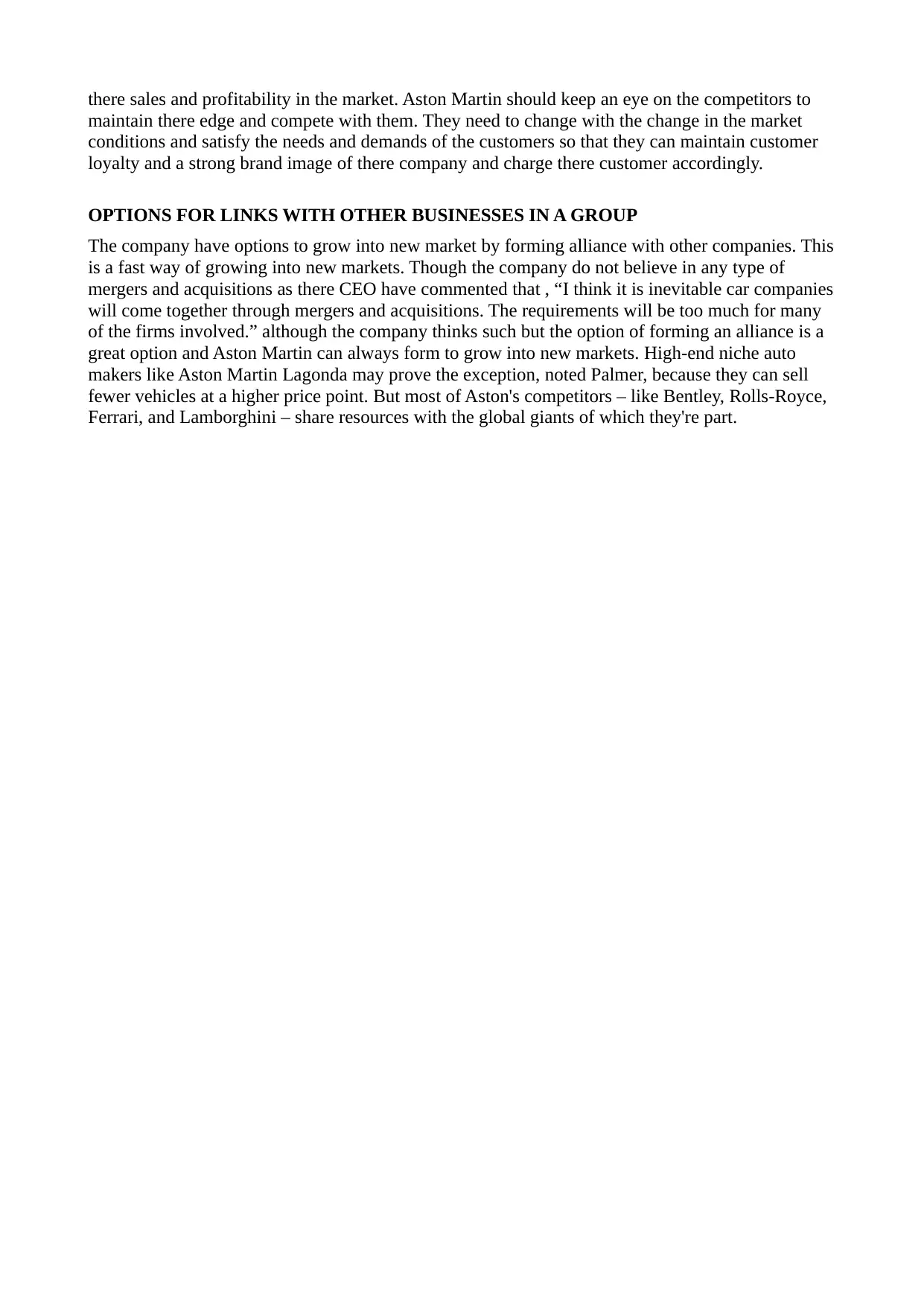
there sales and profitability in the market. Aston Martin should keep an eye on the competitors to
maintain there edge and compete with them. They need to change with the change in the market
conditions and satisfy the needs and demands of the customers so that they can maintain customer
loyalty and a strong brand image of there company and charge there customer accordingly.
OPTIONS FOR LINKS WITH OTHER BUSINESSES IN A GROUP
The company have options to grow into new market by forming alliance with other companies. This
is a fast way of growing into new markets. Though the company do not believe in any type of
mergers and acquisitions as there CEO have commented that , “I think it is inevitable car companies
will come together through mergers and acquisitions. The requirements will be too much for many
of the firms involved.” although the company thinks such but the option of forming an alliance is a
great option and Aston Martin can always form to grow into new markets. High-end niche auto
makers like Aston Martin Lagonda may prove the exception, noted Palmer, because they can sell
fewer vehicles at a higher price point. But most of Aston's competitors – like Bentley, Rolls-Royce,
Ferrari, and Lamborghini – share resources with the global giants of which they're part.
maintain there edge and compete with them. They need to change with the change in the market
conditions and satisfy the needs and demands of the customers so that they can maintain customer
loyalty and a strong brand image of there company and charge there customer accordingly.
OPTIONS FOR LINKS WITH OTHER BUSINESSES IN A GROUP
The company have options to grow into new market by forming alliance with other companies. This
is a fast way of growing into new markets. Though the company do not believe in any type of
mergers and acquisitions as there CEO have commented that , “I think it is inevitable car companies
will come together through mergers and acquisitions. The requirements will be too much for many
of the firms involved.” although the company thinks such but the option of forming an alliance is a
great option and Aston Martin can always form to grow into new markets. High-end niche auto
makers like Aston Martin Lagonda may prove the exception, noted Palmer, because they can sell
fewer vehicles at a higher price point. But most of Aston's competitors – like Bentley, Rolls-Royce,
Ferrari, and Lamborghini – share resources with the global giants of which they're part.

CONCLUSION
In this report there have a discussion about how the Aston Martin can form there organisational
strategies and what factors they must keep in mind. I have used PESTLE analyses to show how
the external factors affects Aston Martin. Then the whole industrial position of Aston Martin is
being discussed. Then the analyses of internal factors has been done through SWOT and VRIO. At
last there is a discussion about the stakeholder perspective in which I have ised the stakeholder
matrix to explain the stakeholder perspective.
In this report there have a discussion about how the Aston Martin can form there organisational
strategies and what factors they must keep in mind. I have used PESTLE analyses to show how
the external factors affects Aston Martin. Then the whole industrial position of Aston Martin is
being discussed. Then the analyses of internal factors has been done through SWOT and VRIO. At
last there is a discussion about the stakeholder perspective in which I have ised the stakeholder
matrix to explain the stakeholder perspective.

REFERENCES
Books and journals
Baruah, B. and Ward, A., 2015. Metamorphosis of intrapreneurship as an effective organizational
strategy. International Entrepreneurship and Management Journal. 11(4). pp.811-822.
Bilgin, M.H., and et.al., 2018. Consumer Behavior, Organizational Strategy and Financial
Economics. Springer.
Fosić, I., Trusić, A. and Šebalj, D., 2017. Digital organizational strategy: Ticket for competitiveness
on the international market. Strategic Management. 22(3). pp.3-10.
George, G. and Schillebeeckx, S.J. eds., 2018. Managing Natural Resources: Organizational
Strategy, Behaviour and Dynamics. Edward Elgar Publishing.
Ibidunni, A.S., Ogunnaike, O.O. and Abiodun, A.J., 2017. Extending the knowledge strategy
concept: Linking organizational knowledge with strategic orientations. Academy of
strategic management journal. 16(3).
Kitchener, M., 2019. The public value of social science: From manifesto to organizational strategy.
In Public Value (pp. 300-315). Routledge.
Peng, M.Y.P., Peng, Y.C. and Chang, C.C., 2018, May. The Effect of Organizational Strategy
Orientation on Network Relationships. In Proceedings of the 2018 International
Conference on E-business and Mobile Commerce. (pp. 30-33). ACM.
Powell, K.K. and Rey, M.P., 2015. Exploring a resource dependency perspective as an
organizational strategy for building resource capacity: Implications for public higher
education universities. Management in Education. 29(3). pp.94-99.
Rantakari, A. and Vaara, E., 2016. Resistance in organizational strategy making. Sage handbook of
organizational resistance. pp.208-223.
Thompson, A., Strickland, A.J. and Gamble, J., 2015. Crafting and executing strategy: Concepts and
readings. McGraw-Hill Education.
ul Musawir, A.and et.al., 2017. Project governance, benefit management, and project success:
Towards a framework for supporting organizational strategy implementation. International
Journal of Project Management. 35(8). pp.1658-1672.
(Baruah and Ward 2015)
(Bilgin, 2018.)
(Fosić, Trusić and Šebalj, 2017)
(George and Schillebeeckx, 2018)
(Ibidunni, Ogunnaike and Abiodun, 2017.)
(Kitchener, 2019)
(Peng, Peng and Chang, 2018)
(Powell and Rey, 2015)
(Rantakari and Vaara, 2016)
(Thompson, Strickland and Gamble, 2015)
(ul Musawir, 2017)
Books and journals
Baruah, B. and Ward, A., 2015. Metamorphosis of intrapreneurship as an effective organizational
strategy. International Entrepreneurship and Management Journal. 11(4). pp.811-822.
Bilgin, M.H., and et.al., 2018. Consumer Behavior, Organizational Strategy and Financial
Economics. Springer.
Fosić, I., Trusić, A. and Šebalj, D., 2017. Digital organizational strategy: Ticket for competitiveness
on the international market. Strategic Management. 22(3). pp.3-10.
George, G. and Schillebeeckx, S.J. eds., 2018. Managing Natural Resources: Organizational
Strategy, Behaviour and Dynamics. Edward Elgar Publishing.
Ibidunni, A.S., Ogunnaike, O.O. and Abiodun, A.J., 2017. Extending the knowledge strategy
concept: Linking organizational knowledge with strategic orientations. Academy of
strategic management journal. 16(3).
Kitchener, M., 2019. The public value of social science: From manifesto to organizational strategy.
In Public Value (pp. 300-315). Routledge.
Peng, M.Y.P., Peng, Y.C. and Chang, C.C., 2018, May. The Effect of Organizational Strategy
Orientation on Network Relationships. In Proceedings of the 2018 International
Conference on E-business and Mobile Commerce. (pp. 30-33). ACM.
Powell, K.K. and Rey, M.P., 2015. Exploring a resource dependency perspective as an
organizational strategy for building resource capacity: Implications for public higher
education universities. Management in Education. 29(3). pp.94-99.
Rantakari, A. and Vaara, E., 2016. Resistance in organizational strategy making. Sage handbook of
organizational resistance. pp.208-223.
Thompson, A., Strickland, A.J. and Gamble, J., 2015. Crafting and executing strategy: Concepts and
readings. McGraw-Hill Education.
ul Musawir, A.and et.al., 2017. Project governance, benefit management, and project success:
Towards a framework for supporting organizational strategy implementation. International
Journal of Project Management. 35(8). pp.1658-1672.
(Baruah and Ward 2015)
(Bilgin, 2018.)
(Fosić, Trusić and Šebalj, 2017)
(George and Schillebeeckx, 2018)
(Ibidunni, Ogunnaike and Abiodun, 2017.)
(Kitchener, 2019)
(Peng, Peng and Chang, 2018)
(Powell and Rey, 2015)
(Rantakari and Vaara, 2016)
(Thompson, Strickland and Gamble, 2015)
(ul Musawir, 2017)
1 out of 10
Related Documents
Your All-in-One AI-Powered Toolkit for Academic Success.
+13062052269
info@desklib.com
Available 24*7 on WhatsApp / Email
![[object Object]](/_next/static/media/star-bottom.7253800d.svg)
Unlock your academic potential
© 2024 | Zucol Services PVT LTD | All rights reserved.





